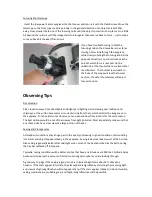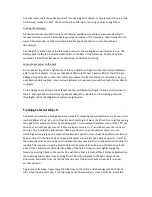
Now pick the eyepiece that the object fits into and enjoy the view. It will be much better than just
going by power alone.
Use of 2” Eyepieces
The Bintel Dobsonian comes with 2” focuser as standard equipment. Because of its large size, it is
able to accept eyepieces that have a 2” barrel diameter. 2” eyepieces are desirable because they
allow for a wider field of view than 1.35” eyepieces. Many observers own at least one 2” eyepiece;
simply remove the 1.25” eyepiece adapter from the end of the focuser drawtube. You must first
loosen the two thumbscrews on the 2” eyepiece adapter to do this. Now insert a 2” eyepiece into
the focuser, and secure it with two thumbscrews. Focus the eyepiece as described previously. You’ll
be stunned at the wide fields of view that 2” eyepieces can deliver. It makes you feel like you’re
floating through space.
Objects to Observe
Now that you are all set up and ready to go, one critical decision must be made: what to look at?
The Moon
With its rocky surface, the Moon is one of the easiest and most interesting targets to view with your
telescope. Lunar craters, Marias, and even mountain ranges can all be clearly seen from an average
distance of 350,000kms away. With its ever-changing phases, you’ll get a new view of the Moon
every night. The best time to observe our one and only natural satellite is during a partial phase, that
is, when the Moon is NOT full. During partial phases, shadows are cast on the surface, which reveal
more detail, especially right along the border between the dark and light portions of the disk (called
the “terminator”). A full moon is too bright and devoid of surface shadows to yield a pleasing view.
Make sure to observe the Moon when it is well above the horizon to get the sharpest images.
Use the included Moon filter to dim the Moon when it is very bright. It simply threads onto the
bottom of the eyepieces (you must first remove the eyepiece from the focuser to attach a filter).
You’ll find that the Moon filter improves viewing comfort, and also helps to bring out subtle features
on the lunar surface. Some coloured filters also help to cast different shadows.
The Planets
The planets don’t stay put like the stars, so to find them you should refer to our website
(www.bintel.com.au/newsletter.html), or to charts published monthly in our newsletter Night Sky or






















